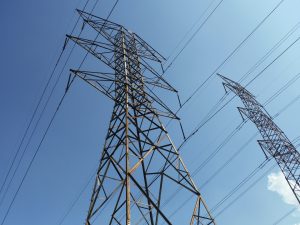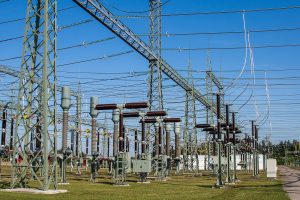Have you ever wondered how electricity is distributed? Where does it come from, and how does it get to your building? How does it get managed en route to your location? It’s not something that we stop to think about too often but there are many moving parts in the process of distributing electricity.
All of this is done by something called an “electrical power distribution system.” This is a system that is responsible for providing electrical power to homes, facilities, and buildings. Not only does it provide this power, but it has to provide it safely and proportionately.

Why is this important? Consider the fact that buildings of different sizes have different electrical needs, and even then that can vary among types of companies and industries. The amount of electricity that is needed to power the building belonging to a multi-national corporation is far greater than the amount of electricity that needs to keep a normal suburban home running.
Therefore, it’s simply not enough to have a universal power source that directly provides electricity to everybody. You need several “points” in the system where the amount of electricity is reduced and divided.
Here is a rough overview of how an electrical distribution system works

You start off with a generating station, which is responsible for generating all of the electricity in the first place. A utility company will own one or several of these stations. Next, the electricity will be carried forward to a generator transformer. A transformer is the device responsible for taking electricity of a certain voltage and exporting that same electricity at a different voltage. It is at this point that you will see the voltage increased. The electricity is then transferred to a transmission substation that increases the voltage yet again using a “step-up transformer.”

Why would you want to increase the voltage prior to distributing it? There is a lot of loss in electricity as you transfer it from cable to cable. Therefore, in order to minimize the losses, you increase the voltage of the electricity in advance. The utility companies know in advance where the electricity will be transferred to and how far it will travel. This means that each transmission substation will increase the voltage by a different, pre-set amount.
The next step is to carry the electricity over to a sub transmission station, where the voltage will be decreased using a “step-down transformer.” At this point in time, we are far closer to the customer(s) that will be receiving the electricity. The electricity is sent to a distribution substation that will further decrease the voltages into various levels, depending on who is receiving it.
Finally, there are transformers located near the customer that will adjust the voltage levels once again until they are low enough to be safely used. At this point, the electricity can be transferred directly to the customer for their own use.
However, you should keep in mind that there is no such thing as a “single” distribution system. Depending on your location, the amount of power you wish to use, and the cost to keep things running, a different system may be more appropriate for you. There are three types of distribution systems that are used to provide electricity:
RADIAL
The radial distribution system is the simplest out of the three. You have a single power source that provides electricity to everybody that is connected to the power source. This power source is usually a large generator that is constantly running.
This is a system that is commonly used due to an easy set-up and a low cost. Radial distribution systems are prominent in residential and suburban areas. It is probably what is providing power to your home right now!
There is only one flaw with this approach yet it is significant: Should a power failure occur, every single person connected to the generator will be directly affected by it and lose power. Whether this power failure is due to a circuit failure or the generator being shut down, all of the people connected to it will suffer.
This is also why you will not see this type of distribution system used for buildings and facilities where the supply of electricity is absolutely crucial. Residents can live with the inconvenience of having their electrical supply cut off, but not everyone has this convenience.
LOOP
As the name implies, a loop distribution system supplies current to the recipient from multiple directions. Setting this up requires more than one generator (i.e., your power source) and the installation of switches within the circuit. The current will loop through the service area and return back to the start. Since this setup requires more equipment and is more complex, it is necessarily more expensive and will require a longer time to install.
However, this flaw is overlooked by the convenience that such a system provides to its customers. If one of the power sources happens to stop working, there is another power source available to provide electricity. The switches can close off the malfunctioning path while it is being repaired and open up the path that can still reliably provide power.
Many large buildings and public facilities will use this kind of a distribution system. It allows them to operate and provide electricity in the face of electrical problems.
NETWORK
A network distribution system is the most complex of the three mentioned with respect to its setup. The recipient is connected to several interconnecting circuits that are powered by multiple generators at once. Much like the loop distribution system, a generator failure is not the end of the world. The other generators in the circuit will provide electricity without any interruption at all. The additional parts and equipment needed to set this up obviously makes this method the most expensive.
You might feel that this is a downside until you see that this is the most reliable setup you can have with regards to having a continuous power source. High-importance buildings such as government facilities, manufacturing complexes, and critical computer storage sites rely on this type of electrical distribution system. Any kind of power failure is of high importance and needs to be dealt with immediately. These types of buildings cannot afford to have any kind of total power failure whatsoever.
It is possible to draw out these distribution systems using something called one-line diagrams. Different symbols are used to note different devices or switches that are used in the system. This is another topic that is beyond the scope of this guide, but this well-written article takes you through the symbols, what they represent, how to interpret these diagrams and how you can draw your own.
Even though loop and network distribution systems are reliable in the event of a power failure, there are still protective measures put in place so that electricity can be safely and continuously provided at an affordable cost.
You might have an overcurrent situation, in which a piece of equipment receives a level of current that it is unable to handle. Overcurrent usually leads to overheating due to the high rise in temperature. This puts stress on the system and consequently damages it. In particular, it is the insulation for the cable carrying the electricity that takes the most damage.
There are three types of overcurrent that can occur:
- Overloads – where abnormally high loads are placed on a current to the point where the insulation breaks down and the temperature between the conductor and the insulation rises.
- Short Circuits – where the insulation fails, leading to excessively high currents flowing through and the current and damaging the entire system.
- Ground Faults – a subset of short circuits where there is a short circuit taking place between the ground and one of the phases.
Of course, all of these things are regulated by the electrical industry through a series of codes and standards that are set up for everybody to follow. These have been designed through numerous years of experience and observation. They will continue to change as technology continues to improve and novel safety situations are discovered. Everyone is expected to abide by these rules when it comes to manufacturing, designing, testing, and using all types of equipment.
These standards largely differ from one another depending on several factors. Your location will affect the guidelines you follow, as every country has different rules. Your industry will also affect how you approach electrical safety since different industries have different electrical needs. For this reason, you will find that standards are not always required or mandatory. Keep in mind that although standards may change, everyone is required to get the proper testing for equipment through independent testing laboratories.
Codes, on the other hand, are mandatory to follow and hold strict consequences for people who do not follow them. These codes govern the type of equipment to use in a given scenario, how to properly install equipment (and where), and how to use them. There are numerous types of standards and codes in existence, as one set of rules is unable to cover every single piece of electrical equipment that exists in the world.
If you are ever unsure on how to approach using a piece of equipment, you will usually find some good indicators on the equipment itself. Whether it is attached to the equipment or the packaging that it comes in, you can find the standards and codes that will pertain to that piece of equipment. Sometimes you may be lucky enough to find safety warnings and instructions for proper handling.
All of this can be very confusing for somebody who is new to this subject. Many workers will spend a few years working with the rules before they become intimately familiar with them. Even then, they are often required to review their safety training on an annual basis and provide reliable guidance to new workers. It is important to consult with a reliable expert who can help you understand these rules, and/or install and safely use the equipment that you are going to be working with.
